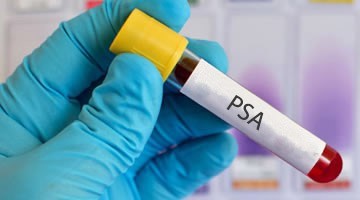Health Articles
An intro to the PSA
A PSA test is a blood test used to measure the level of PSA in the blood. Many have heard the 3 letter abbreviation, especially if you are a man over 50, but what exactly is a PSA? PSA is the abbreviation for Prostate-Specific Antigen, which is a protein produced by the cells of the prostate gland. The PSA is often called a biological or tumor marker because it can be used to detect disease. The disease in this case is prostate cancer. Therefore the PSA test measures the level of PSA in the blood, like we mentioned above, in order to screen for prostate cancer.
In combination with a digital rectal exam, the PSA blood test is our first line of defense against prostate cancer, especially in those men who do not present symptoms. The PSA is also important for men who have already been treated for prostate cancer. Close monitoring of the PSA after treatment can be used to determine whether a man has experienced biochemical recurrence or the potential reoccurrence of cancer.
What is considered normal and abnormal?
Generally speaking, there is no specific normal or abnormal PSA level. The PSA is not a perfect diagnostic test, and as such we rely on other factors such as age, family history, medical history, and background to help us get a clearer picture of what is “normal” for each patient. The amount of PSA present in the blood tends to increase with increasing age. So what is normal for a 70 year old, may not be normal for a 40 year old. With that said, 4 ng/mL is often considered the upper limit of normal. Generally, the higher the PSA level, the more likely that cancer is present.
What is PSA velocity?
PSA velocity is the rate at which your PSA level increases from year to year. This rate of change in PSA levels over time, can give crucial information to a doctor about your potential for cancer. A rapid increase in PSA or PSA doubling time can be a sign of a rapidly growing cancer. Physicians have suggested that a PSA velocity that is over 0.35 ng/mL per year is the cut off for a high PSA velocity. Therefore an increase of about .65 or .7 in PSA per year can be indicative of prostate cancer, and should be closely monitored and further followed up by a physician.
Some other PSA related evaluations can similarly give physicians added information about a man’s risk of prostate cancer. These include PSA density and percent of free PSA. The PSA density evaluates the relationship between the level of PSA detected and the size of the prostate. This helps assess elevated PSA’s in men with enlarged prostates, for example, who may have elevated scores due to the size of the prostate, but not comparatively to those with smaller prostates. Percentage of free PSA on the other hand is a measure of amount of PSA which circulates in the blood. The PSA can be identifies in two forms, attached to certain blood proteins or unattached, aka free. According to research, a low ratio of free PSA to total PSA can increase the risk of a prostate cancer diagnosis. Overall, men with BPH will have higher free PSA whereas those with cancer will have a higher proportion of attached PSA.

